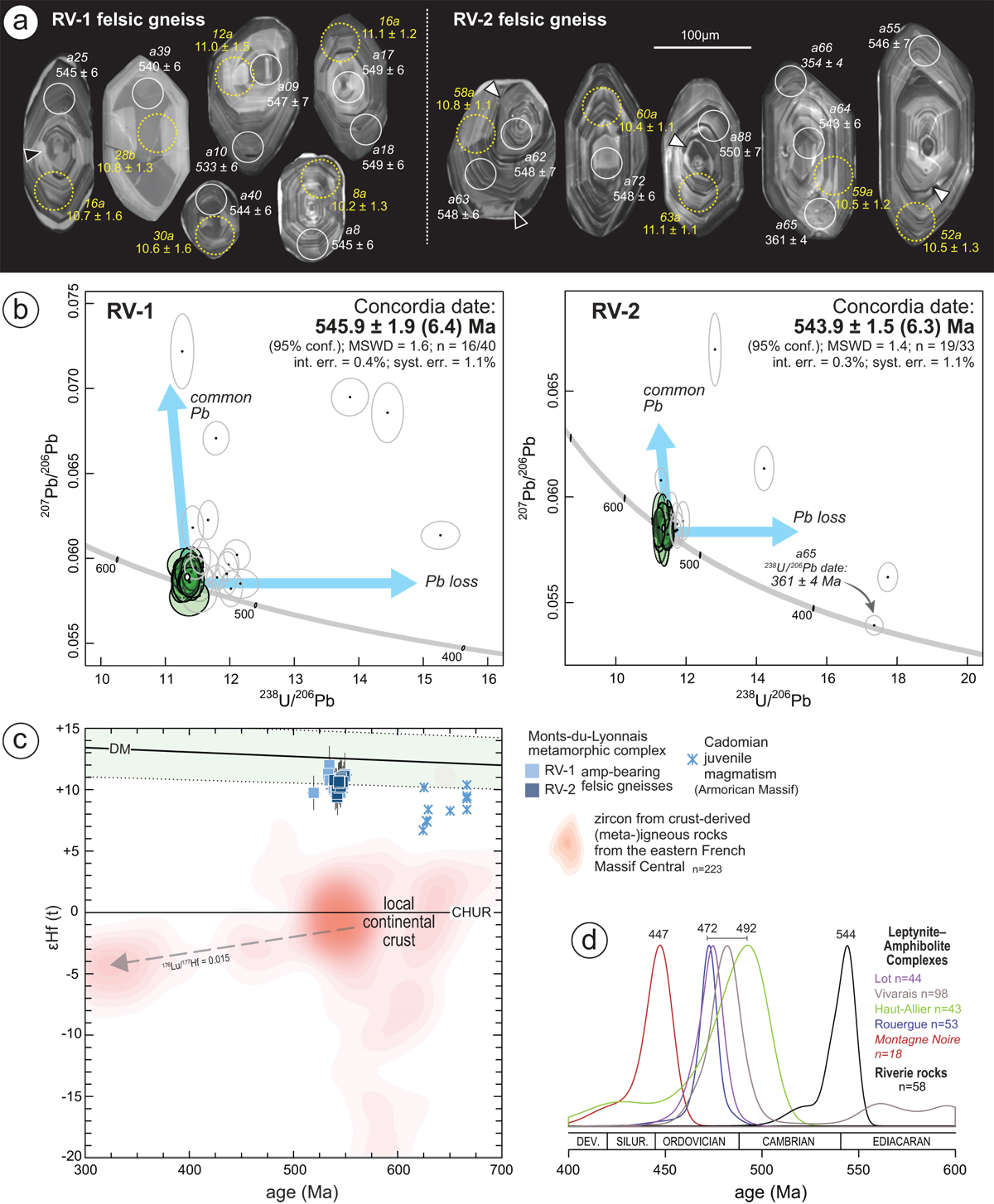Fig. 5

Download original image
Zircon textural and U–Pb–Hf data for the Riverie amphibole gneisses. (a) Representative cathodoluminescence images with the locations of laser spots (white and yellow circles for U–Pb and Lu–Hf analyses respectively) indicated along with the spot name (aXX or YYa/b). The corresponding 206Pb/238U dates are quoted with 2σ uncertainty, in Ma. All displayed analyses are concordant (except those in italic). Hf isotope data are reported using the εHf calculated at the 206Pb/238U date obtained on the same zircon domain, quoted with 2σ uncertainty. The white and black triangles highlight changes in the zoning pattern and local grain recrystallization, respectively. Laser spot sizes are 30 μm for U–Pb and 40 μm for Lu–Hf. (b) Tera-Wasserburg diagrams (238U/206Pb vs. 207Pb/206Pb). Error ellipses and ages are displayed at 95% level of uncertainty. Green ellipses are those considered for Concordia age calculations. The reported MSWDs are those of concordance plus equivalence. (c) Measured εHf(t) on magmatic zircon grains, recalculated and plotted using the 206Pb/238U date. When such value was not available, the crystallization age determined for the sample was used. The range for the Depleted Mantle reservoir is bracketed by the models of Naeraa et al., (2012) and Griffin et al., (2002). The background red shading mimics the contours of the distribution of 223 zircon analyses from crust-derived felsic (meta-)igneous rock from the French Massif Central (Chelle-Michou et al., 2017; Couzinié et al., 2017; Moyen et al., 2017). These data are taken as representative of the Hf isotopic composition of the local continental crust. Data for the Armorican Massif Cadomian juvenile arc magmatism are from Samson et al., 2003. An εHf(t)–time crust evolution array calculated with an average 176Lu/177Hf ratio of 0.015 (Griffin et al., 2002) is also depicted. (d) Available LA–ICP–MS zircon U–Pb data on meta-igneous rocks from the “Leptynite–Amphibolite Complexes” in the eastern French Massif Central (represented as Kernel Density Estimates of concordant 206Pb/238U dates (calculated with IsoplotR using an adaptative bandwith). Zircon data are from Whitney et al., (2020) for the Montagne Noire, de Hoÿm de Marien et al., (2023) for the Haut-Allier, Paquette et al., 2017 for the Lot, Lotout et al., (2020, 2018); for the Rouergue, Chelle-Michou et al., (2017) for the Vivarais, and this study for the Monts-du-Lyonnais.
Données texturales et U-Pb-Hf des zircons extraits des gneiss de Riverie. (a) Images en cathodoluminescence montrant la zonation magmatique des grains et la localisation de quelques points d’analyse. (b) Diagrammes Tera-Wasserburg. Les ellipses vertes sont celles considérées pour les calculs d’âge Concordia. (c) Valeurs de εHf des grains de zircon recalculées à l’âge de mise en place. L'arrière-plan rouge représente la composition isotopique en Hf de la croûte continentale de l’Est du Massif Central. (d) Données U-Pb sur zircons obtenues pour les roches méta-ignées des "complexes leptyno-amphiboliques" de l’Est du Massif Central français.
Current usage metrics show cumulative count of Article Views (full-text article views including HTML views, PDF and ePub downloads, according to the available data) and Abstracts Views on Vision4Press platform.
Data correspond to usage on the plateform after 2015. The current usage metrics is available 48-96 hours after online publication and is updated daily on week days.
Initial download of the metrics may take a while.




